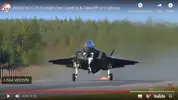The first fighter pilots graduated in Finland
Norwegian fighter pilots now receive their basic training in two places, both in the USA and in Finland. It is the first time in over 40 years that these pilots are trained elsewhere than in Texas.
- The supply of combat aircraft training internationally is lower than the demand right now, and that is a challenge for both us and our allies, says Brigadier Kristian Lyssand, head of the Air Force's Weapons School.
The fighter planes, T-38, which the Norwegian students use in the USA, faced some challenges this year and last year. Until they solved the engine problems, they had to reduce the number of students. This in turn led to challenges for the Air Force about not being able to train enough of its own Norwegian fighter pilots.
- We looked at alternative solutions, and we rated Finland as the absolute best, says Lyssand.
From before, the Air Force has collaborated with the Finns for many years, and regularly trained and practiced together.
- That is why we also know that Finland has high-quality pilots, continues Lyssand.
Recently, the first three Norwegian fighter pilots were graduated. The training takes place at Tikkakoski Airbase, near Tampere. The planes used are of the HAWK type, which are British-made training planes for fighter pilots.
The three started their basic education in 2023. Before this, they have been through selection at the flight school and two years at the Air Force Academy.
The students will now complete their education in Finland, which, after the wing award, focuses more on training tactical skills in the coming months. They will then go on to the F-35 check-out at Luke Air Force Base in Arizona, together with their cohort mates who have completed their training at Sheppard Air Force Base in Texas.
- There are some cultural differences between education in Finland and the USA. Both countries have structured and clear frameworks. The Finns can be a bit more pragmatic, for example with the weather conditions. Having Russia as a neighbor also does something to the culture. Among other things, they fly in worse weather and lower than in the USA. In Finland, they also practice more advanced air training and air to ground training, says Lyssand.










